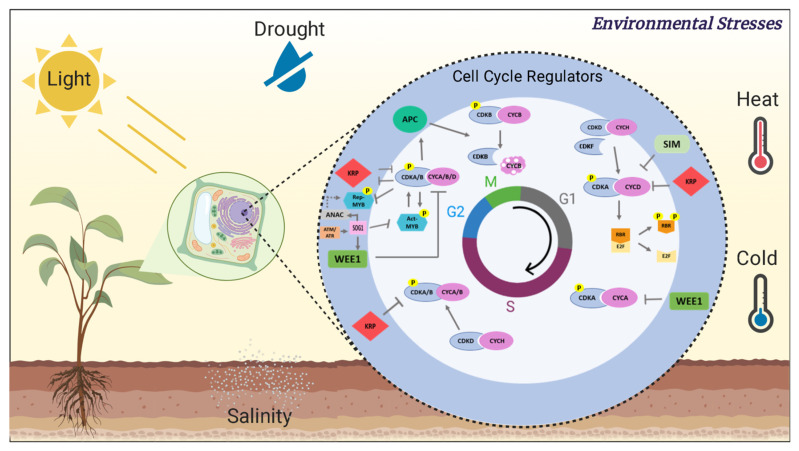Figure 1.
The influence of the environment on cell cycle regulation. The proliferation of cells in plants is composed of two successive steps: interphase and mitosis. At the end of G1, CYCD-CDKA phosphorylates the RBR protein, thus releasing the E2F and DP heterodimer, promoting transcription of key genes for G1/S transition. CYCDs are active in both G1/S and G2/M. During the cycle, the CDK-activating kinase (CAK) proteins, CDKD and CDKF, act by phosphorylating and activating CDKA/B. CDKF has independent activity, unlike what occurs with CDKD, which requires interaction with cyclin H. In G2, CDKA/B interact with CYCA/B/D and phosphorylate and activate Act-MYB, which in turn induces the expression of G2/M specific genes, including mitotic cyclins that interact with CDKA/B. In contrast, CDKA/B–CYCA/B/D phosphorylate and destabilize Rep-MYBs to prevent their binding to the MSA element, which is important for the G2/M transition. Under unfavorable environmental conditions, CDK inhibitors such as WEE, SIM, and KRP sense external signals and inhibit CDK activity to arrest the cell cycle. DNA damage is sensed by ATM/ATR, which phosphorylate and activate SOG1 to trigger DDR. SOG1 induces the expression of ANAC044/085 and CKIs and indirectly represses Act-MYB expression. ANAC044/085 stabilize Rep-MYBs, which in turn repress the expression of G2/M-specific genes arresting the cycle at G2. During mitosis, CDKA/B phosphorylate and activate APC/CCDC20, promoting the destruction of CYCB and consequently the inactivation of CDKB to allow mitotic exit. Abbreviations: ACT-MYB—activator-type MYB3R; REP-MYB—repressor-type MYB3R; SOG1—suppressor of gamma response 1; ATM—ataxia telangiectasia mutated; ATR—ATM- and RAD3-related; DDR—DNA damage response; CDK—cyclin-dependent kinase; CYC—cyclin; APC/C—anaphase-promoting complex/cyclosome; SIM—siamese; CKI—CDK inhibitor; NAC—domain transcription factors; KRP—ICK/KIP-related protein. Dotted arrow—indirect mechanism; continuous arrow—induction; block arrow—repression. Created with BioRender.com.

